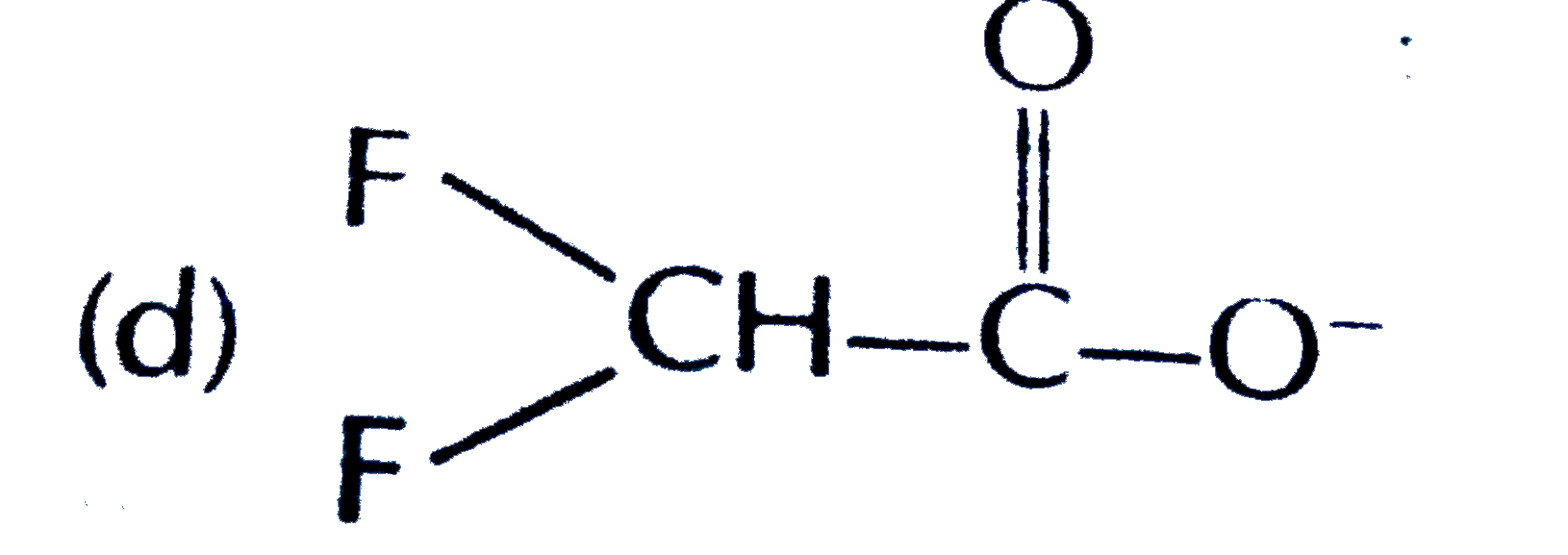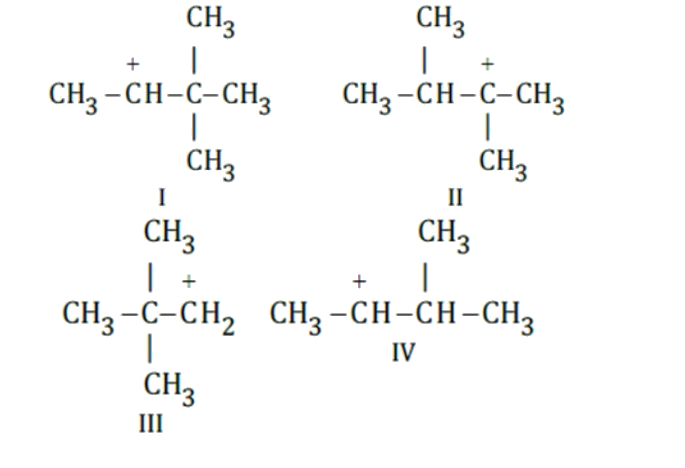Ionic species are stailised by the dispersal of charge. Which of the following carboxylate ion is the most stable ?
CH3−O∣∣C−O−
Cl−CH2−O∣∣C−O−
F−CH2−O∣∣C−O−

The correct Answer is:D
To determine which carboxylate ion is the most stable, we need to analyze the resonance stabilization and the effect of substituents on the stability of the carboxylate ions. Here’s a step-by-step solution:
Step 1: Understand the Structure of Carboxylate Ions
Carboxylate ions have the general structure RCOO⁻, where R is a hydrocarbon group. The negative charge resides on one of the oxygen atoms, and this charge can be delocalized through resonance.
Hint: Remember that resonance can stabilize a negative charge by spreading it over multiple atoms.
Step 2: Identify the Electron-Withdrawing Groups
Electron-withdrawing groups (EWGs) stabilize negative charges by pulling electron density away from the negatively charged atom. The more effective the EWG, the more stable the carboxylate ion will be.
Hint: Look for groups that are known to withdraw electrons, such as halogens or nitro groups.
Step 3: Analyze Each Option
1. Option A: Contains a methyl group (−CH₃), which is an electron-donating group. This will destabilize the carboxylate ion.
2. Option B: Contains a chlorine atom (−Cl), which is an electron-withdrawing group (−I effect). This will provide some stabilization to the carboxylate ion.
3. Option C: Contains a fluorine atom (−F), which is more electronegative than chlorine and thus has a stronger −I effect. This will provide greater stabilization than chlorine.
4. Option D: Contains two fluorine atoms (−F). The presence of two electronegative fluorine atoms will enhance the −I effect even more, leading to the highest stabilization of the carboxylate ion.
Hint: Compare the strength of the electron-withdrawing effects of the groups present in each option.
Step 4: Compare the Stabilization Effects
- Methyl group (A) destabilizes the ion.
- Chlorine (B) provides moderate stabilization.
- Fluorine (C) provides greater stabilization than chlorine.
- Two fluorines (D) provide the greatest stabilization due to the cumulative −I effect.
Hint: The more electron-withdrawing groups present, the more stable the carboxylate ion will be.
Step 5: Conclusion
Based on the analysis, the carboxylate ion in Option D is the most stable due to the presence of two fluorine atoms, which exert a strong electron-withdrawing effect.
Final Answer: Option D is the correct answer.
Carboxylate ions have the general structure RCOO⁻, where R is a hydrocarbon group. The negative charge resides on one of the oxygen atoms, and this charge can be delocalized through resonance.
Electron-withdrawing groups (EWGs) stabilize negative charges by pulling electron density away from the negatively charged atom. The more effective the EWG, the more stable the carboxylate ion will be.
1. Option A: Contains a methyl group (−CH₃), which is an electron-donating group. This will destabilize the carboxylate ion.
2. Option B: Contains a chlorine atom (−Cl), which is an electron-withdrawing group (−I effect). This will provide some stabilization to the carboxylate ion.
- Methyl group (A) destabilizes the ion.
- Chlorine (B) provides moderate stabilization.
- Fluorine (C) provides greater stabilization than chlorine.
- Two fluorines (D) provide the greatest stabilization due to the cumulative −I effect.
Based on the analysis, the carboxylate ion in Option D is the most stable due to the presence of two fluorine atoms, which exert a strong electron-withdrawing effect.
Topper's Solved these Questions
- BOOK - NCERT EXEMPLAR ENGLISHCHAPTER - ORGANIC CHEMISTRY : SOME BASIC PRINCIPLES AND TECHNIQUESEXERCISE - Short Answer type question27videos
ORGANIC CHEMISTRY : SOME BASIC PRINCIPLES AND TECHNIQUES
- BOOK - NCERT EXEMPLAR ENGLISHCHAPTER - ORGANIC CHEMISTRY : SOME BASIC PRINCIPLES AND TECHNIQUESEXERCISE - Matching the columns5videos
ORGANIC CHEMISTRY : SOME BASIC PRINCIPLES AND TECHNIQUES
- BOOK - NCERT EXEMPLAR ENGLISHCHAPTER - HYDROGENEXERCISE - LONG ANSWER TYPE QUESTIONS8videos
HYDROGEN
- BOOK - NCERT EXEMPLAR ENGLISHCHAPTER - REDOX REACTIONSEXERCISE - LONG ANSWER TYPE QUESTIONS6videos
REDOX REACTIONS
Similar Questions
Knowledge Check
- Question 1 - Select One
Ionic species are stabilised by the dispersal of charge. Which of the following carboxylate ion is the most stable?
ACH3−O∣∣C−O−BCl−CH2−O∣∣C−O−CF−CH2−O∣∣C−O−Dd10lpgp6xz60nq.cloudfront.net/physics_images/NCERT_OBJ_FING_CHE_XI_C12_E03_011_O04.png" width="30%"> - Question 2 - Select One
Which of the following carbocations is expected to be most stable?
A B
B C
C D
D
- Question 3 - Select One
Which of the following carbanion expected to be most stable?
Ap−NO2C^H4−CH2Bo−NO2C6H4−CH2Co−CHOC6H4CH2Dp−CHOC6H4CH2
Which of the following carbocations is most stable ?
 View Solution
View SolutionWhich of the following carbocations is most stable ?
View SolutionWhich of the following carbocation is most stable
View SolutionWhich of the following carbocation is most stable?
View SolutionWhich of the following compound is thermally most stable ?
View Solution

